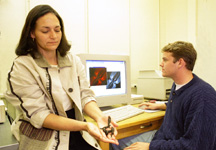 Purdue News
Purdue News
 Purdue News
Purdue News
December 1996

|
The Purdue group now is conducting follow-up studies to see what role NOS may play in neural regeneration. The findings may someday be applied to research in human spinal regeneration. Details of the study were presented Nov. 21 at the annual meeting of the Society for Neuroscience.
"Our study shows that NOS in the leech is activated at the site of injury within minutes after axons are severed, and it remains active well beyond 48 hours after the injury," Sahley says. Axons are the long "arms" of a nerve cell that carry impulses away from the cell body toward a target cell.
"We are now conducting follow-up studies to identify what information this molecule provides at a cellular level, and to see how these functions might help the leech's nervous system set itself up to allow regeneration to occur," she says.
NOS, an enzyme also found in humans, produces a "signaling" molecule that sends chemical messages throughout the body to incite certain chemical reactions. Because the NOS found in leeches is very much like the human NOS, it may serve a similar function in both species, Sahley says.
"Nerve cells in leeches are basically identical in structure and function to those in more complicated systems such as humans," Sahley says. "But for some reason, nerve regeneration in higher systems is not complete. By analyzing how nerves regenerate in a simple system, we may find clues to facilitate regeneration in vertebrates."
When activated, NOS produces nitric oxide, a gas that in recent years has been recognized to act as a signaling molecule in vertebrates, including humans. As a signaling molecule, nitric oxide sends chemical messages to other molecules, setting up a chain of command to produce a specific response or set off a series of chemicals reactions.
Studies show that the NOS enzyme plays a role in a number of functions, such as learning and feeding, and is activated in response to neuronal injury in several organisms, including mammals.
Though it has been tied to a number of functions, scientists have not yet identified how NOS operates at a cellular level.
"We suspect that NOS plays an important role in the organization of many events, but we have not yet determined how it sends its signals or what specific molecules it targets," Sahley says. "Our goal in this study is to narrow it down and see, in a regenerating system, who this protein talks to and what it does at any specific time."
Her studies suggest that nitric oxide may serve as a "stop sign" for microglia, specialized cells that roam the central nervous system to ingest foreign particles, such as bacteria and dead cells. By flagging down microglia to help at the site of injury, nitric oxide may aid efforts to minimize tissue damage and infection. Sahley is pursuing studies to test this hypothesis.
Sahley says the medicinal leech, Hirudo medicinalis , is an ideal model for studying the basic processes behind neural regeneration. "Not only do their neurons reconnect after injury, but they have been shown capable of making the right connections to fully restore motor function," she says.
Humans and other vertebrates, by comparison, have only limited capacity to restore neural growth or function.
One problem with studying neural regeneration in vertebrate systems is that there are hundreds of thousands of neurons, making it impossible to identify what each individual cell does, she says.
By contrast, the medicinal leech has 21 identical columns of neurons, called ganglia, which run up and down its body. Each ganglion is made up of only 400 neurons.
"Because we're looking at the connections between 400 neurons, rather than thousands, we can track the NOS to an individual cell and monitor its function, both within the cell and within the system," she says.
The 21 ganglia that make up the nervous system of the leech "talk" to each other through a connective, a structure somewhat like a spinal cord without the spine. The connective is made up of numerous axons that allow the ganglia to send messages to each other.
In her study, Sahley and Shafer used a pair of fine forceps to crush the connective, severing the axons running from ganglia to ganglia. The injury was immediately followed by a staining process to detect the presence of active NOS.
Their findings showed that the NOS remained localized to the site of the injury -- never staining beyond the pinch -- indicating that NOS plays an active role at the site where the injury occurs.
"We found one particular form of NOS that shows up only at the site of the crush," Sahley says. "We are now conducting follow-up studies to identify what information this particular signaling molecule gives the regenerating nervous system."
In addition, the staining results suggest the nitric oxide might be involved in the rapid microglial accumulation that follows injuries to the connectives.
Sahley and Shafer cultured some of the pinched connectives in the presence of an NOS inhibitor to see what happened when the signaling process was blocked. After 24 hours of regeneration, the groups without the inhibitor showed tight gatherings of microglia around the area of injury, while those treated with the inhibitor showed a scattered distribution of microglia, spread well beyond the site of injury.
Sahley now has several experiments under way to test whether NOS acts as a "stop sign" to hold microglia at the site of injury. She also is working to identify other molecules within cells that may play a role in the regeneration process.
The research is funded by the National Institutes of Health and the National Institute of Mental Health.
smg/sahley.leech/9611f28
Sources: Christie Sahley, (765) 494-0127; e-mail, csahley@bilbo.bio.purdue.edu
Orie Shafer, (765) 494-0126; e-mail, oshafer@bilbo.bio.purdue.edu
Writer: Susan Gaidos, (765) 494-2081; e-mail, susan_gaidos@purdue.edu
Purdue News Service: (765) 494-2096; e-mail, purduenews@purdue.edu
Photo Caption:
Color photo, electronic transmission, and Web and ftp download available. Photo ID:
Sahley/Leech
Download here
.
ABSTRACT